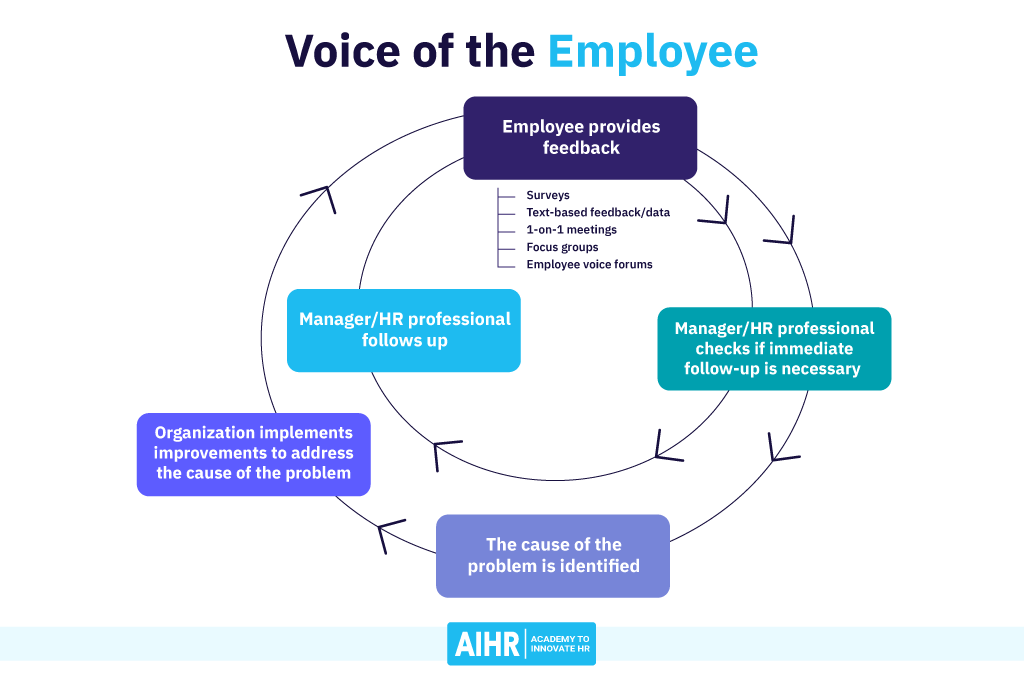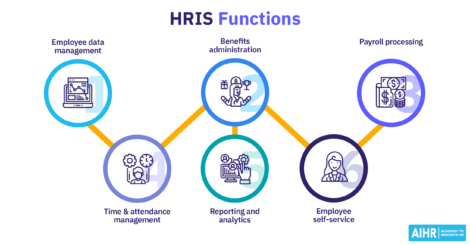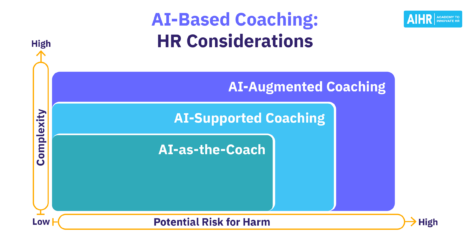Voice of the Employee: All You Need to Know

A Voice of the Employee program gives employees opportunities to share their opinions with their organization. The company can then act on the (employee) feedback, creating a better workplace for their employees with business goals in mind. How can you benefit from a VoE program at your organization? Let’s find out.
Contents
What is the Voice of the Employee?
Why is Voice of the Employee important?
Voice of the Employee best practices
What is the Voice of the Employee?
Voice of the Employee (VoE) is a systematic process designed to uncover and assess employee concerns or problems that impact the total employer-employee relationship.
In this process, employees can honestly air their needs, wishes, hopes, and preferences, without facing the negative consequences in the workplace.
Organizations collect VoE data through employee surveys, feedback systems, employee engagement software, as well as one-on-one conversations and discussions. Then, they analyze the data to identify issues and points of improvement.
In other words, the aim is to act upon the findings to improve work relationships, business processes, and the whole organization.
Why is Voice of the Employee important?
Creating a Voice of the Employee program may be a significant undertaking but consider the benefits of having one:
Understanding the work environment from the point of view of your employees
Employees learn more about their role, team, and the organization when they ask questions. However, this also works vice versa – employers learn about the employees’ perception of the work environment when they ask questions.
That’s why you must empower your employees to say what’s on their minds. For example, they should be encouraged to make suggestions that they think will help them perform better at work or improve team productivity levels.
VoE emphasizes building communication channels between managers and employees to enhance employee experience.
Boosting employee engagement
One of the significant benefits of having an employee voice program is enhanced employee engagement.
Employees who feel that their feedback is taken seriously and contributes to creating a better workplace are more engaged. Employee engagement improves business performance. Sales increase, revenues grow, and company culture is enhanced. What’s more, engaged employees are five times less likely to be involved in a workplace accident.
Increasing employee retention
Employee retention increases when there is a high employee satisfaction rating.
Employee satisfaction can rely a lot on their having a voice and being listened to, whether it’s about an idea they have had or about a complaint they need to make.
Plenty of research cites that businesses with healthy communication practices (healthy dialogue between managers and direct reports) reduced their employee turnover rates.
Making processes more effective
Feedback from your employees enables you to discover inefficiencies and redesign your processes to be more effective.
Whether it’s recruitment, onboarding, performance management, career advancement, or other HR activities, employees can provide valuable observations about what’s working and what’s not.
Let’s say that your Voice of the Employee program includes a post-onboarding survey where you ask your new hires about their onboarding experience. The analysis of the survey results shows that your employees find the first-day job orientation confusing and providing insufficient information. That’s a signal for you to review your job orientation process and implement changes.
Improving customer experience
Employees directly interact with customers in different ways. And these interactions provide insights into customer wants, expectations, satisfaction, etc.
Collecting these insights from employees can help organizations understand their customers better, and they can equip their employees to adequately serve them.
Voice of the Employee best practices
When you’ve made the decision to start your own VoE program, keep in mind the following best practices to get the most out of it:
1. Set the goals for your VoE program
Before setting up your VoE program, you should set your goals first.
Ask yourself what you want to achieve.
For instance, you might want to improve your employee benefits strategy, or your goal might be to design interventions to enhance your organizational culture. Based on that, the way you collect the data and the questions you ask will differ.
2. Determine how to measure employees’ voice
How do you collect the data for your VoE program?
An employee survey is the most common method of gathering and analyzing the employee voice with quantitative data:
- Employee engagement surveys pose questions that determine how committed employees are to helping their companies achieve their goals.
- Employee satisfaction surveys analyze the state of a worker enjoying their job.
- Employee exit surveys help employers gather and understand why employees leave the company.
Aside from (employee) surveys, you can also gather quantitative and qualitative data via engagement platforms.
There are several ways to gather qualitative data.
For example, you can conduct employee focus group discussions and interviews to collect more qualitative feedback highlighting key issues. You can also organize one-on-one meetings with the leadership team. Such interactions enable managers to understand an individual deeper and make personalized recommendations based on their own experiences.
An airline logistics company developed an employee voice forum “where staff representatives could raise issues directly with members of senior-level staff.“
Another option is to create an employee board with rotating memberships where suggestions are placed. You can also set up a staff task force to search for current challenges your business faces.
Ideal for small teams, managers can also allow the best performers to join management team meetings. Encourage such employees to present their innovative ideas to upper management. It can also encourage others to do well at work to get involved in such a high-level business process.
You can add text-based feedback from other channels like social media posts, Glassdoor reviews, emails, and even internal communication channels like Slack data. Don’t forget to anonymize the data while you’re at it!
3. Prepare relevant questions
You can use both open-ended and close-ended questions in your VoE program.
Using close ended-questions with a numerical scale (e.g. 1-5) generates quicker and more straightforward insights. It also helps in getting measurable and quantitative data.
On the other hand, open-ended questions deliver a clearer picture of the thoughts and feelings of your employees that no/yes answers couldn’t provide.
Combining both types of questions is recommended to get the best results.
As mentioned, there are different types of employee surveys. Check out the following examples of employee survey questions:
Employee satisfaction:
- Do you find purpose in your work?
- Do you think your company provides enough opportunities for promotion and career development?
- What tools and technologies do you think you need to do your job well?
- Do you feel like your job uses your skills and abilities as much as possible?
- How happy are you at work?
Employee engagement:
- Does your supervisor commend you when doing a good job?
- Do you feel the employee assessment process is fair?
- Are your peers/colleagues receptive to your suggestions?
- Do you feel the amount of work assigned to you is just and fair?
- How does your company support a healthy work-life balance?
Employee exit:
- How much did the job role change after you got hired?
- What were the best and worst parts of your job?
- How did you feel your total compensation package (pay + benefits + any equity) was compared to other companies?
- Why are you leaving the company?
- On a scale of 1-10, how likely are you to recommend the organization to your family/friends?
4. Collect your data regularly
Your VoE program shouldn’t be a one-time initiative. Instead, plan the data collection in regular intervals, ideally quarterly or every six months.
For instance, the Swedish office of Nexans, a global company in the cable and optical fiber industry, conducts a weekly four-question survey. The results are compiled into a report, which the management discusses on a weekly basis. This VoE program has helped them increase employee satisfaction.
To put it another way, it’s essential to consider your business and goals whenever you conduct surveys. For example, you have to ensure that having weekly or monthly surveys won’t lead to survey fatigue.
Also, you’ll want to know what your employees think after you’ve implemented something based on their feedback.
5. Encourage employees to participate
Answering surveys after long hours in the office can be taxing for employees.
This is where you explain why it’s important that they take part and incentivize them to participate.
Incentives don’t just mean cash money. A simple way to reward the feedback process is by showing employees that managers are taking action based on the survey responses.
When employees realize that the leaders are acting on their concerns, they recognize the result is worth the effort, and they will be more motivated to participate the next time.
Nexans shares the weekly survey results with the whole branch, which has helped them to get their survey response rate to 93%.
6. Analyze the data
Once you’ve collected the data, conduct your analysis.
As we’ve already mentioned, VoE programs use various processes to gather and analyze employee feedback. Data sources include surveys, employee NPS, performance evaluation, employee forums, social networks, focus groups, and exit interviews.
You can use Excel to work with quantitative data from close-ended survey answers to compute percentages and statistics. Check out our detailed guide to employee engagement survey analysis to learn how to analyze your survey results.
If you’re analyzing unstructured, text-based information, consider the Natural Language Processing (NLP) technology that automates the processing and analysis of text content to make it manageable and structured. Analyzing qualitative data generated from open-ended questions like complaints, opinions, and sentiments generates a deeper and more nuanced result.
The NLP technology uses topic extraction, classification, sentiment analysis, clustering, and profiling to listen, analyze and measure employee feedback.
Using an NLP-powered VoE analytics software like Lexalytics Intelligence Platform empowers you to analyze such text-based employee feedback in minutes with so-called sentiment analysis. HR can use this software to make better decisions around training, compensation, work environment, etc.
Another VoE tool, WorkTango, allows managers to respond to employee comments to continue the conversation. They also provide suggestions based on employee survey scores on key questions. Their data-powered tool also gives employers an idea of which categories of questions significantly influence the company’s overall score.
If you want to develop your digital dexterity and learn how to implement HR technology that adds value, check out our Digital HR Certificate Program.
Example
One example is the analysis of reasons for turnover from exit surveys. In a survey, it’s typically an open field where employees explain the reason for moving on. Most HR departments don’t analyze this type of unstructured properly.
However, that’s precisely where you find the most relevant data that can help you reduce employee turnover. Because it’s anonymous, the only fields included in this survey are tenure in a company and positive and negative aspects of staying with the company. Both areas are open responses.
A text analytics company MeaningCloud set out to analyze the causes of employee turnover or ‘talent flight’ within a company based on exit interview data. Some of the questions the company wanted to be answered included:
- Is the company unfriendly toward new arrivals?
- Do people leave the company after having spent several years with the company, and they don’t see their career progressing as they had expected?
MeaningCloud used a classification model where they assigned a text to one or more categories within a predefined taxonomy. Essentially, they were able to categorize the reasons to leave as follows:
JobOffer
JobOffer>BetterSalary
JobOffer>ProfessionalImprovement
JobOffer>BetterWork/LifeBalance
NewExperience
NewExperience>LanguageLearning
NewExperience>WorkAbroad
Workload
Workload>LackOfWork
LeaveOfAbsence
WorkEnvironment
WorkEnvironment>Conflict
Policies&Practices
PersonalReasonsHere are a couple of insights MeaningCloud was able to yield from the analysis:
- The employees who have been in the company for less than 12 months complained about the absence of communication within teams and the organization.
- The employees who had been with the company for one to three years cited salary and growth opportunities as negative factors.
- The veteran employees in the company said weak points were employee motivation, co-worker expertise, and salary.
7. Take action
After analyzing the results and drawing conclusions, it’s time to take action.
Come up with ideas and start implementing them. For example, based on the results of the analysis above, the company in question can design employee retention strategies for different stages of the employee life cycle. This could be focus on internal communication especially with new hires, and improving growth opportunities for experienced employees.
Then repeat the process – conduct your VoE analysis and design new improvements based on your findings.
A final word
Voice of the Employee is an excellent tool for uncovering your employees’ needs and preferences, resolving workplace issues before they have a serious impact, and creating an inclusive, productive work environment. That’s well worth the effort you need to put in.
Weekly update
Stay up-to-date with the latest news, trends, and resources in HR
Learn more
Related articles
Are you ready for the future of HR?
Learn modern and relevant HR skills, online












